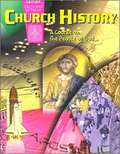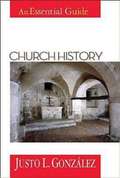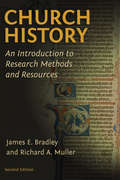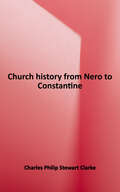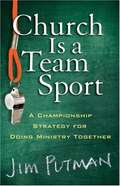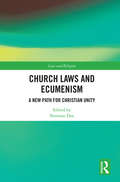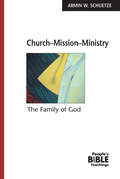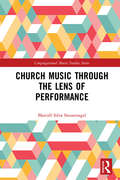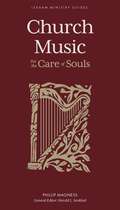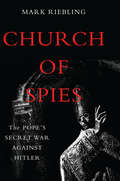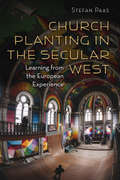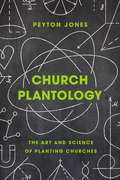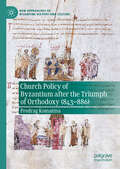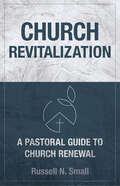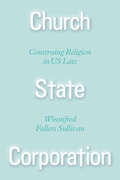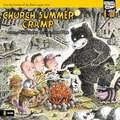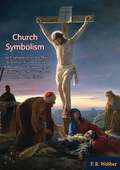- Table View
- List View
Church History-student Text: Apostolic Times To Today
by Joanna Dailey Gloria ShahinThis course examines the events of the Church's life, the contributions to human life it has made, and studies the challenges the Church has faced overtime, from her earliest history.
Church History: A Course on the People of God (Sadlier Faith and Witness)
by Thomas J. ShelleyChurch History: A Course on the People of God by Thomas J. Shelley.
Church History: An Essential Guide (Essentials Guide Ser.)
by Justo L. GonzalezOne of the chief difficulties in studying the history of Christianity is the lack of prior exposure to the subject that students often bring with them. Struggling to keep up with the large numbers of names, dates, and places presented to them, it is easy for students to lose sight of the "big picture," the broad sweep of movement and change that instructors most wish to communicate. Justo Gonzalez has written this book to help students gain just such a quick and basic grasp of the main periods and issues in the history of Christianity. Drawing upon his own extensive experience and that of others, he contends that having been introduced to the essentials of church history in a brief and accessible form, students are far better able to understand and appreciate what they encounter in more detailed lectures and reading.Gonzalez provides a comprehensive opening chapter that summarizes major issues and concerns of each of the principal eras of church history. Subsequent chapters focus on the ancient church, the Christian empire, the Middle Ages, the Reformation, the seventeenth through nineteenth centuries, and the twentieth century and the end of modernity.
Church History: An Introduction to Research Methods and Resources
by Richard A. Muller James E. BradleyIn their acclaimed, much-used Church History, James Bradley and Richard Muller lay out guidelines, methods, and basic reference tools for research and writing in the fields of church history and historical theology. Over the years, this book has helped countless students define their topics, locate relevant source materials, and write quality papers. This revised, expanded, and updated second edition includes discussion of Internet-based research, digitized texts, and the electronic forms of research tools. The greatly enlarged bibliography of study aids now includes many significant new resources that have become available since the first edition’s publication in 1995. Accessible and clear, this introduction will continue to benefit both students and experienced scholars in the field.
Church History: An Introduction to Research Methods and Resources
by Richard A. Muller James E. BradleyIn their acclaimed, much-used Church History, James Bradley and Richard Muller lay out guidelines, methods, and basic reference tools for research and writing in the fields of church history and historical theology. Over the years, this book has helped countless students define their topics, locate relevant source materials, and write quality papers. This revised, expanded, and updated second edition includes discussion of Internet-based research, digitized texts, and the electronic forms of research tools. The greatly enlarged bibliography of study aids now includes many significant new resources that have become available since the first edition&’s publication in 1995. Accessible and clear, this introduction will continue to benefit both students and experienced scholars in the field.
Church History: From Nero to Constantine
by C. P. S. ClarkeCharles Philip Stewart Clarke (1871 to 1947) was a prominent Anglican priest and author who wrote numerous works on religion. This history describes the transformation of Christianity from its inception as a small and obscure sect, persecuted by the state and despised by the general population, to become the state religion of the mighty Roman Empire. It is an objective study of the religious philosophies current in Rome during the early days of the church, the dissensions within the Church; the imperial persecutions, the various heresies, the rival religions, and the many writers who helped to define Christianity. The attitudes of early Christians toward family life, women, virginity, business, amusements, military service, and slavery, are described. Clarke describes the guidelines that the church fathers established for a “Christian” lifestyle. He discusses the rituals, organization, and discipline of the early Church. He describes the forty-year truce with the Empire during which the Church experienced unprecedented expansion and wealth, and paganism attempted to revive itself. He concludes with the terrible ten years of persecution under the emperor Diocletian, after which the Church and the Empire finally became reconciled under Constantine the Great.
Church Is a Team Sport: A Championship strategy for doing Ministry together
by Jim PutmanFrom the Locker room to the Elder Board Room, Coaching God’s Championship Team, Developing Skilled Players, On the Offensive, We are the Champions.
Church Laws and Ecumenism: A New Path for Christian Unity (Law and Religion)
by Norman DoeWritten by experts from within their communities, this book compares the legal regimes of Christian churches as systems of religious law. The ecumenical movement, with its historical theological focus, has failed to date to address the role of church law in shaping relations between churches and fostering greater mutual understanding between them. In turn, theologians and jurists from the different traditions have not hitherto worked together on a fully ecumenical appreciation of the potential value of church laws to help, and sometimes to hinder, the achievement of greater Christian unity. This book seeks to correct this ecumenical church law deficit. It takes account of the recent formulation by an ecumenical panel of a Statement of Principles of Christian Law, which has been welcomed by Pope Francis and the Ecumenical Patriarch of Constantinople, leader of the Orthodox Church worldwide, as recognizing the importance of canon law for ecumenical dialogue. This book, therefore, not only provides the fruits of an understanding of church laws within ten Christian traditions, but also critically evaluates the Statement against the laws of these individual ecclesial communities. The book will be an essential resource for scholars of law and religion, theology, and sociology. It will also be of interest to those working in religious institutions and policy-makers.
Church Leadership & Strategy: For the Care of Souls (Lexham Ministry Guides)
by Harold L. Senkbeil Lucas V. WoodfordChrist's sheep need shepherding. That's where you come in. With more than 60 years of ministry between them, Harold Senkbeil and Lucas Woodford have come to understand that everything in ministry—even administration, leadership, and planning—revolves around the ancient tradition of the care of souls. Pastors are entrusted with the care of a flock by the Good Shepherd and are called to be faithful to this task. But pastoring seems to be getting more and more difficult. Based on a sound theological framework, Senkbeil and Woodford present a set of practical tools for church leadership and strategy. Calling on their vast experience, they encourage pastors to protect, guide, and feed their flock as Jesus would, bridging the eternal wisdom of the word of God with the everyday practicality of hands-on leadership.
Church Leadership: Vision, Team, Culture, Integrity, Revised Edition
by Lovett H. Weems JR.Much has changed since the first edition of Lovett Weems’s seminal work Church Leadership appeared in 1993. In that time a substantial literature about leading the congregation has appeared, written from a broad variety of perspectives. But in some ways, little has changed in that time. The need for leadership in the church—defined as discovering the faithful future into which God is calling the congregation, and walking with the congregation into that future—is just as pressing as it ever was. And for that reason, the need for clear, insightful thinking about leadership is just as great as it ever was. In this revised edition, Weems draws on the best new ideas and research in organizational leadership, yet always with his trademark theological grounding foremost in mind. Anyone who guides the life of a congregation, be they clergy or laity, will find Church Leadership the indispensable tool with which to follow their calling to be a church leader.
Church Militant Field Manual: Special Forces Training for the Life in Christ
by Richard M. Heilman Joseph BalistreriGod wants you, but He wants you "strong" in His supernatural power. From the very first days of our membership in the Mystical Body of Christ, we are, in essence, commissioned officers in the Church Militant. <p><p>This Church Militant Field Manual will test you in your resolve to become strong in the Lord and His mighty power. You will also learn the special operations (special ops) techniques and procedures for search and rescue missions of fallen comrades (family and friends whose faith has grown weak). Discover what it means to be "God strong."
Church Militant: Bishop Kung and Catholic Resistance in Communist Shanghai
by Paul P. MarianiBy 1952 the Chinese Communist Party had suppressed all organized resistance to its regime and stood unopposed, or so it has been believed. Internal party documents—declassified just long enough for historian Paul Mariani to send copies out of China—disclose that one group deemed an enemy of the state held out after the others had fallen. A party report from Shanghai marked “top-secret” reveals a determined, often courageous resistance by the local Catholic Church. Drawing on centuries of experience in struggling with the Chinese authorities, the Church was proving a stubborn match for the party. Mariani tells the story of how Bishop (later Cardinal) Ignatius Kung Pinmei, the Jesuits, and the Catholic Youth resisted the regime’s punishing assault on the Shanghai Catholic community and refused to renounce the pope and the Church in Rome. Acting clandestinely, mirroring tactics used by the previously underground CCP, Shanghai’s Catholics persevered until 1955, when the party arrested Kung and 1,200 other leading Catholics. The imprisoned believers were later shocked to learn that the betrayal had come from within their own ranks. Though the CCP could not eradicate the Catholic Church in China, it succeeded in dividing it. Mariani’s secret history traces the origins of a deep split in the Chinese Catholic community, where relations between the “Patriotic” and underground churches remain strained even today.
Church Mission Ministry: The Family of God (People's Bible Teachings)
by Armin W SchuetzeWhat does it mean to be a part of the family of God?In the Bible, God calls all who believe in him his children (2 Corinthians 6:18). But what is our purpose as believers here on earth?Church-Mission-Ministry looks at what God says in his Word and what he assigns his people—his church—to do. This book also examines the nature of the church, its people, and its practices, as outlined in the Scriptures.After reading this book, you’ll have a better idea of what it means in the family of God!The People’s Bible Teachings is a series of books on all the main teachings of the Bible. Following the pattern set by The People’s Bible series, these books are written for all Christians in an easy-to-read manner. The authors of The People’s Bible are all pastors and professors who have had years of experience teaching others about the Bible.
Church Music Through the Lens of Performance (Congregational Music Studies Series)
by Marcell Silva SteuernagelThis book is an investigation into church music through the lens of performance theory, both as a discipline and as a theoretical framework. Scholars who address religious music making in general, and Christian church music in particular, use "performance" in a variety of ways, creating confusion around the term. A systematized performance vocabulary for the study of church music can support interdisciplinary investigations of Christian congregational music making in today’s complex, interconnected world. From the perspective of performance theory, all those involved in church musicking are performing, be it from platform or pew. The book employs a hybrid methodology that combines ethnographic research and theory from ritual studies, ethnomusicology, theology, and church music scholarship to establish performance studies as a possible "next step" in church music studies. It demonstrates the feasibility of studying church music as performance by analyzing ethnographic case studies using a developmental framework based on the concepts of ritual, embodiment, and play/change. This book offers a fresh perspective on Christian congregational music making. It will, therefore, be a key reference work for scholars working in Congregational Music Studies, Ethnomusicology, Ritual Studies and Performance Studies, as well as practitioners interested in examining their own church music practices.
Church Music: For the Care of Souls (Lexham Ministry Guides)
by Phillip MagnessThe Lord's song sings faith into people's hearts. Music is central to the life of the church. In Church Music: For the Care of Souls, Phillip Magness helps the church to recover the primary instrument in worship: congregational voices. With voices raised, we sing praises to our God and King for his Son Jesus Christ. Singing calls for a special kind of leadership—not only on the part of musicians, but also among pastors and lay leaders. Together, leaders can help congregations find their voice and reclaim the power of music for the care of souls.
Church Of Spies: The Pope's Secret War Against Hitler
by Mark RieblingThe Vatican’s silence in the face of Nazi atrocities remains one of the great controversies of our time. History has accused wartime pontiff Pius the Twelfth of complicity in the Holocaust and dubbed him “Hitler’s Pope. ” But a key part of the story has remained untold. Pius ran the world’s largest church, smallest state, and oldest spy service. Saintly but secretive, he skimmed from church charities to pay covert couriers, and surreptitiously tape-recorded his meetings with top Nazis. When he learned of the Holocaust, Pius played his cards close to his chest. He sent birthday cards to Hitler—while secretly plotting to kill him. Church of Spies documents this cloak and dagger intrigue in shocking detail. Gun-toting Jesuits stole blueprints to Hitler’s homes. A Catholic book publisher flew a sports plane over the Alps with secrets filched from the head of Hitler’s bodyguard. The keeper of the Vatican crypt ran a spy ring that betrayed German war plans and wounded Hitler in a briefcase bombing. The plotters made history in ways they hardly expected. They inspired European unification, forged a U. S. -Vatican alliance that spanned the Cold War, and challenged Church teachings on Jews. Yet Pius’ secret war muted his public response to Nazi crimes. Fearing that overt protest would impede his covert actions, he never spoke the “fiery words” he wanted. Told with heart-pounding suspense, based on secret transcripts and unsealed files, Church of Spies throws open the Vatican’s doors to reveal some of the most astonishing events in the history of the papacy. The result is an unprecedented book that will change perceptions of how the world’s greatest moral institution met the greatest moral crisis in history.
Church Planting in Post-Christian Soil: Theology and Practice
by Christopher B. JamesNational headlines regularly herald the decline of Christianity in the United States, citing historically low levels of confidence in organized religion, drops in church attendance, church closures, and the dramatic rise of the "Nones." Scarcely heard are stories from the thousands of new churches and new forms of church that are springing up each year across the country. In this book, Christopher James attends carefully to stories of ecclesial innovation taking place in Seattle, Washington―a city on the leading edge of trends shaping the nation as a whole. James's study of the new churches founded in 'post-Christian' Seattle offers both pragmatic advice and theological reflection. <p><p> After an in-depth survey- and -interview-based analysis of the different models of church-building he identifies, James identifies five threads of practical wisdom: 1) embracing local identity and mission, 2) cultivating embodied, experiential, everyday spirituality, 3) engaging community life as means of witness and formation, 4) prioritizing hospitality as a cornerstone practice, and 5) discovering ecclesial vitality in a diverse ecclesial ecology. Stimulating, encouraging, and stereotype-shattering, this book invites readers to reconsider the narrative that portrays these first decades of the twenty-first century as a time of ecclesial death and decline, and to view this instead as a hope-filled season of ecclesial renewal and rebirth.
Church Planting in the Secular West: Learning from the European Experience (The Gospel and Our Culture Series (GOCS))
by Stefan PaasAn expert study of church planting in the most secular part of contemporary Europe In this book Stefan Paas offers thoughtful analysis of reasons and motives for missionary church planting in Europe, and he explores successful and unsuccessful strategies in that post-Christian secularized context. Drawing in part on his own involvement with planting two churches in the Netherlands, Paas explores confessional motives, growth motives, and innovation motives for church planting in Europe, tracing them back to different traditions and reflecting on them from theological and empirical perspectives. He presents examples from the European context and offers sound advice for improving existing missional practices. Paas also draws out lessons for North America in a chapter coauthored with Darrell Guder and John Franke. Finally, Paas weaves together the various threads in the book with a theological defense of church planting. Presenting new research as it does, this critical missiological perspective will add significantly to a fuller understanding of church planting in our contemporary context.
Church Plantology: The Art and Science of Planting Churches (Exponential Series)
by Peyton JonesThe first comprehensive textbook on effective church planting from a veteran church planter.The Apostle Paul was a veteran church planter who "laid a foundation like a wise and master builder" and there is much we can learn from his example. Paul indicated that there were basic skills and experiences required to successfully plant a church. Church Plantology examines the wide variety of church planting methods and ideologies in contemporary pastoral practice and outlines a biblical model based on the New Testament.During his time in prison, Paul spent much of his time writing to Titus, Timothy, and others who'd served alongside him in the trenches to complete their training as church plantings. We can continue to apply these time-tested, proven methods, following the pioneering example of the early church.Today, the casualty rate in is high. What if we could reduce the odds of failing? Church Plantology by Peyton Jones is a robust guide to planting that will help planters to provide the foundation necessary to survive beyond the initial first years so that they don't end up a walking statistic.
Church Policy of Byzantium after the Triumph of Orthodoxy (New Approaches to Byzantine History and Culture)
by Predrag KomatinaThe book deals with the policy of the Byzantine state in the field of ecclesiastical matters from the end of Iconoclasm in 843 to the death of Emperor Basil I in 886. It examines the attitude of the main political actors – the emperors and their closest collaborators – towards religious matters and the decisions they made concerning the various issues of Iconoclasm and Orthodoxy, appointment of the patriarchs, relations with the Church of Rome, and theological disputes with Muslims, non-Chalcedonian Christians, and Christian sects. This volume also considers missionary activity outside the borders of the Empire and policy towards religious minorities inside them, as well as the political and intellectual potential behind it.
Church Revitalization: A Pastoral Guide to Church Renewal
by Russell N. SmallChurch Revitalization guides current and future leaders through the often-complex process of bringing a church to a place of vibrancy. This book demonstrates how the overarching goal of seeing people come to faith in Christ and develop into Christlikeness can—and must—inform the most foundational to the most fleeting aspects of revitalizing a struggling church. Church Revitalization Strategist Rusty Small systematically walks readers through the many considerations of leading a church out of a decline. He helps identify the best approach for addressing what a particular church’s revitalization need may be: Refresh – often most fitting after a difficult season in the church’s life Renovate – needed when a decline has lasted five to ten years Restore – appropriate for churches with generational patterns focused on survival Replant – best for a church facing imminent closure Few joys compare to seeing God’s life and power realized for the local church—when believers begin to think and serve as Jesus did. Small will encourage pastors and church leaders engaged in this critical task. If God is calling you to church revitalization, take and read!
Church State Corporation: Construing Religion in US Law
by Winnifred Fallers SullivanChurch and state: a simple phrase that reflects one of the most famous and fraught relationships in the history of the United States. But what exactly is “the church,” and how is it understood in US law today? In Church State Corporation, religion and law scholar Winnifred Fallers Sullivan uncovers the deeply ambiguous and often unacknowledged ways in which Christian theology remains alive and at work in the American legal imagination. Through readings of the opinions of the US Supreme Court and other legal texts, Sullivan shows how “the church” as a religious collective is granted special privilege in US law. In-depth analyses of Hosanna-Tabor v. EEOC and Burwell v. Hobby Lobby reveal that the law tends to honor the religious rights of the group—whether in the form of a church, as in Hosanna-Tabor, or in corporate form, as in Hobby Lobby—over the rights of the individual, offering corporate religious entities an autonomy denied to their respective members. In discussing the various communities that construct the “church-shaped space” in American law, Sullivan also delves into disputes over church property, the legal exploitation of the black church in the criminal justice system, and the recent case of Masterpiece Cakeshop v. Colorado Civil Rights Commission. Brimming with insight, Church State Corporation provocatively challenges our most basic beliefs about the ties between religion and law in ostensibly secular democracies.
Church Summer Cramp (Tales from the Back Pew)
by Mike ThalerWith hilarious stories and nutty pictures, the Tales from the Back Pew series offers kid’s a unique view of church. Enjoy plenty of giggles with your child—and learn fun, important truths about God, church, and the Bible. Mom’s sending me to church summer cramp—I mean, camp. The woods are full of poison ivy, and you become a mosquito burrito and eat in a mess hall. Yuck!
Church Symbolism; an Explanation of the More Important Symbols of the Old and New Testament,: the Primitive, the Mediaeval and the Modern Church
by F. R. Webber"Church Symbolism: An Explanation of the More Important Symbols of the Old and New Testament, the Primitive, the Medieval and the Modern Church" by F. R. Webber is an authoritative and comprehensive guide to the rich tapestry of symbols that have been used throughout the history of the Christian Church. Webber, an esteemed scholar and historian, provides readers with an in-depth understanding of the significance and evolution of these symbols from biblical times to the present day.This meticulously researched work delves into the origins and meanings of various Christian symbols, exploring their roots in both the Old and New Testaments. Webber traces the development of these symbols through the early church, the medieval period, and into modern Christian practice, offering a thorough analysis of how they have been adapted and interpreted over the centuries.The book covers a wide array of symbols, including well-known ones such as the cross, the fish, and the lamb, as well as more obscure symbols that have played significant roles in Christian art and worship. Webber's explanations are clear and insightful, making complex theological concepts accessible to a broad audience."Church Symbolism" is richly illustrated with images and diagrams that enhance the reader's understanding of the symbols discussed. Each chapter provides historical context, scriptural references, and interpretations that illuminate the deeper spiritual meanings behind these symbols. Webber's scholarly yet engaging writing style ensures that readers, whether laypersons or academics, will find this book both informative and inspiring.This volume is an invaluable resource for clergy, theologians, historians, and anyone interested in the visual and symbolic language of Christianity. F. R. Webber's "Church Symbolism" not only educates but also invites readers to appreciate the profound beauty and significance of the symbols that have shaped Christian faith and practice for millennia. It is a must-read for those seeking to deepen their understanding of the rich heritage of Christian symbolism.
Church Transfusion: Changing Your Church Organically--From the Inside Out (Jossey-Bass Leadership Network Series #63)
by Neil Cole Phil HelferJust as our life is in our blood, the life for Christ’s body is in His blood. Changing a church is more than a new goal or direction. Our churches need more than an organizational transition; we need a full transfusion of Jesus' blood, His life, within every disciple. Anything less than that will only perpetuate more of the dysfunction and unhealthy church practices that have already plagued us for too long. We are in desperate need of the internally transforming power of the gospel of grace and the presence of Christ so that our salvation is then worked out in a way the rest of the world will notice. It isn’t enough that we believe in the facts contained in the gospel, we must allow the gospel itself to infect our souls and transform us from within. The DNA of Jesus' lifeblood is needed in our churches and nothing shy of a full transfusion that touches every cell will be sufficient. In this book Neil Cole (author of Organic Church, Church Transfusion and Journeys to Significance) and Phil Helfer, co-founders of Church Multiplication Associates, will first point out that change is possible with God, but only with God. In the second half of the book they will lay out some of the actual practical considerations to weigh if you want to release real organic health in your church. Using multiple examples of very different kinds of churches that have been through the process, the authors present ways that leadership and practices need to change in order to release organic church movements from their midst. Chapters cover: Leadershifts necessary Detoxification from dependence issues. How to ignite change virally. How to grandparent movements. How to measure success in movements. This book (another in the Leadership Network series) applies organic life principles to established churches with practical help that is holistic and natural. The content in this book will be helpful whether you are pastor of an established church or wanting to revitalize a small organic church. Jesus didn’t die and rise from the dead so that we can be like everyone else in the world. Our faith is more than just a better doctrine or a bigger goal with a capital giving campaign; it is a better life. Jesus is the difference, and what a difference he makes...don't be satisfied with less.

